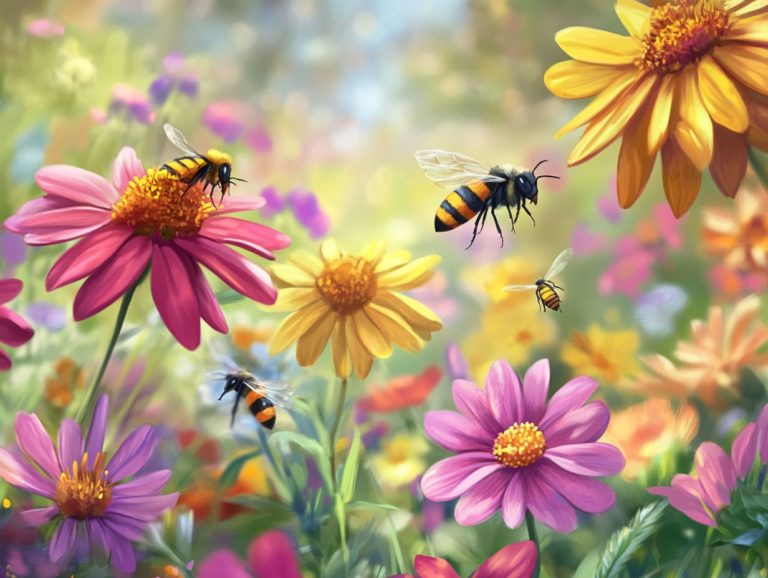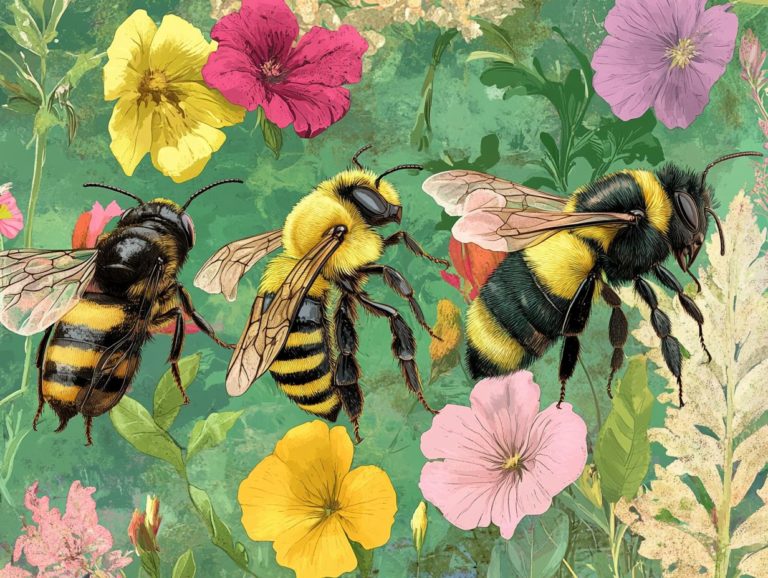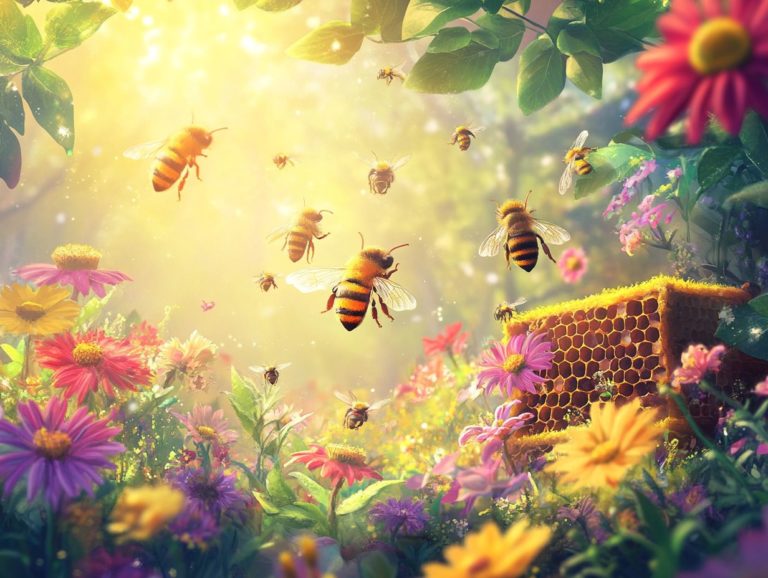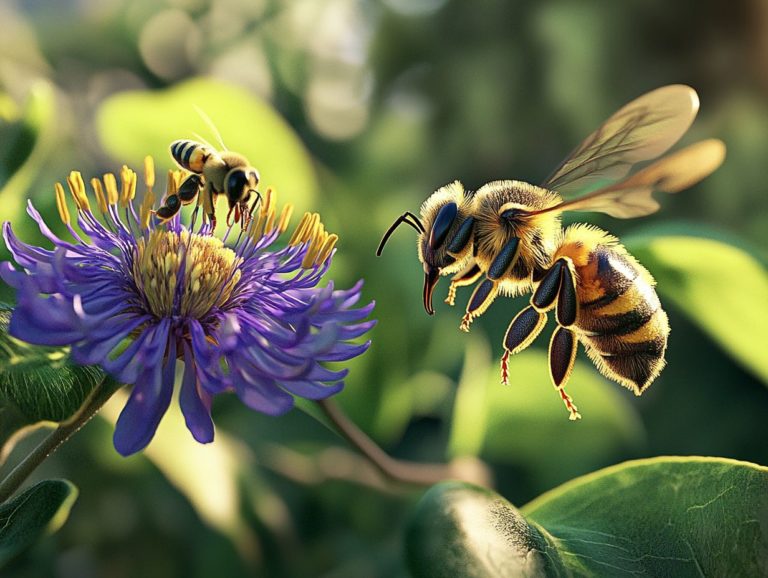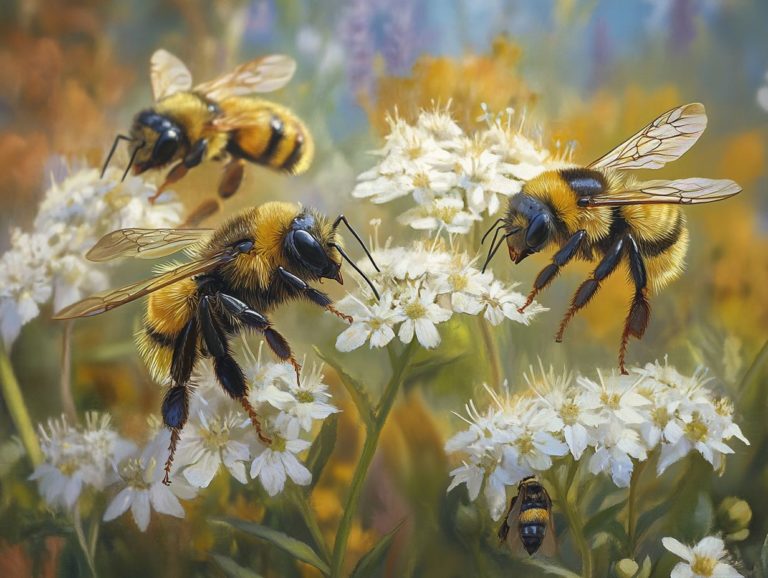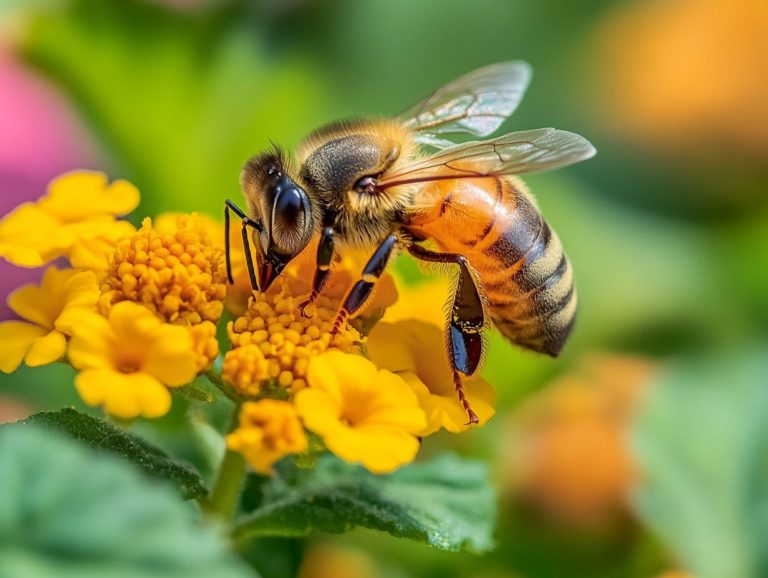Beekeeping and Rare Bee Species
Beekeeping transcends mere hobby status; it stands as a vital practice that underpins our ecosystems, food systems, and the health of bees.
As you delve into the world of beekeeping, you’ll uncover its various forms and the crucial role it plays in our environment. You’ll also discover the multitude of benefits it offers. However, beekeeping is not without challenges, particularly concerning rare and endangered bee species.
Let s discover why these species matter and how we can protect them!
Engage with us as we navigate this buzzing topic and explore how both beekeepers and individuals can contribute to a brighter future for these indispensable pollinators.
Contents
- Key Takeaways:
- What is Beekeeping?
- Why Beekeeping Matters
- What Are Rare Bee Species?
- What Are the Most Endangered Bee Species?
- How Can Beekeepers Help Protect Rare Bee Species?
- What Can Individuals Do to Help Protect Rare Bee Species?
- Frequently Asked Questions
- What is beekeeping and why is it important for rare bee species?
- What makes a bee species rare?
- How can beekeepers help to protect and support rare bee species?
- Are there any specific techniques or methods used in beekeeping for rare bee species?
- Are there any laws or regulations in place for beekeeping and protecting rare bee species?
- Can I still enjoy the benefits of beekeeping if I am focused on preserving rare bee species?
Key Takeaways:
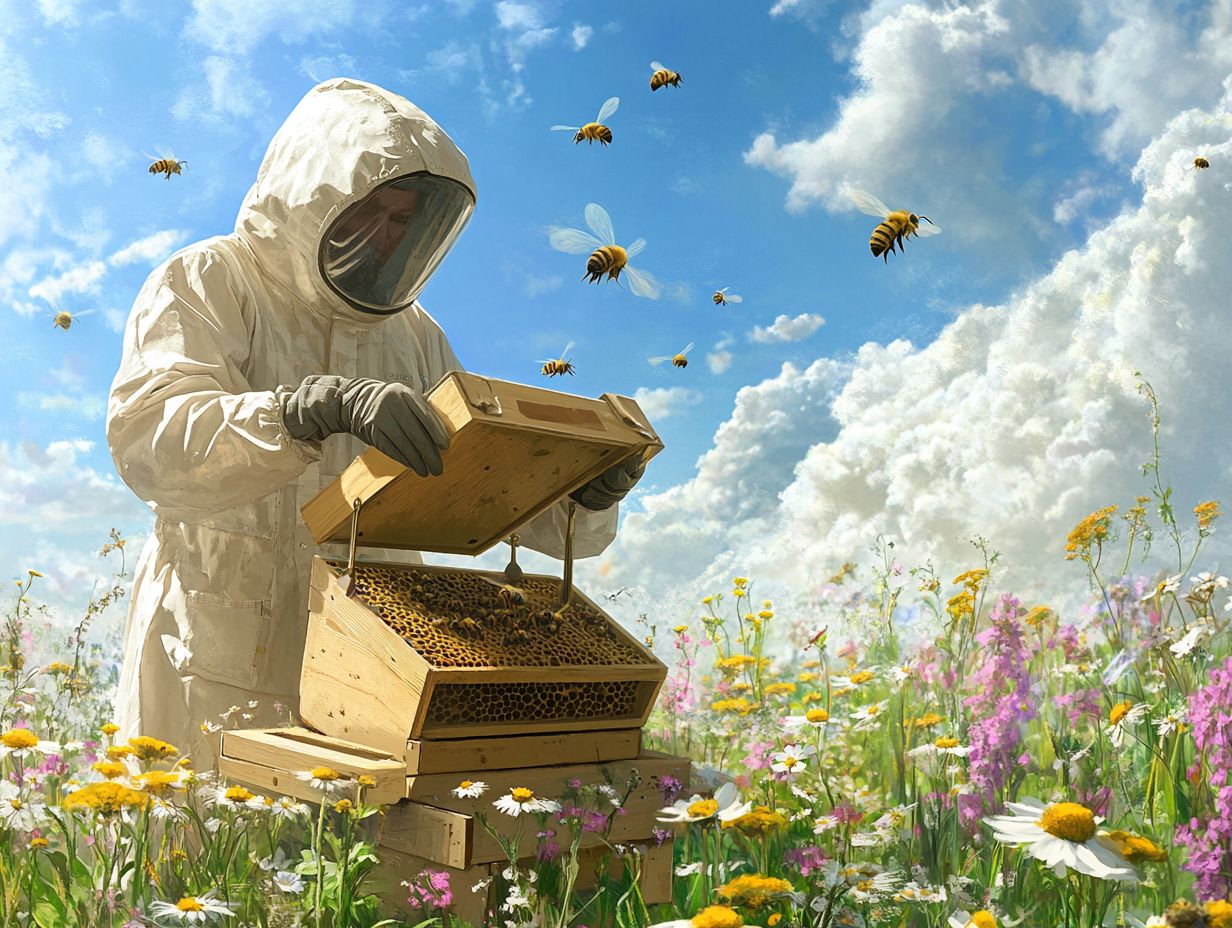
- Beekeeping is the practice of keeping and managing bee colonies for their honey and other beneficial products.
- Beekeeping is essential for healthy pollination, helping our food systems thrive.
- Rare bee species, including distinct subspecies and unique bee families, are important for maintaining biodiversity. Their decline threatens the environment and agriculture.
What is Beekeeping?
Beekeeping is the art of maintaining bee colonies, often housed in man-made hives. It involves the careful management and nurturing of various bee species, including honey bees, bumble bees, and solitary bees. This age-old practice goes beyond honey production; it plays a crucial role in enhancing the health of bee populations and the environment by facilitating the pollination of flowering plants.
Understanding the different types of bees and their behaviors is essential for successful beekeeping. Experts like Noah Wilson-Rich, author of “State of the Honey Bee,” emphasize that understanding the unique families and behaviors of bees is crucial for appreciating their vital contributions to the ecosystem.
Explore Different Types of Beekeeping
You ll discover a variety of beekeeping practices tailored to the diverse species of bees. Traditional beekeeping, for instance, focuses on honey bee production, while more specialized practices support solitary bees and other families, such as the Apidae, the Halictidae, and the Melittidae.
Urban beekeeping has surged in popularity, allowing city dwellers to connect with honey bees and promote pollinator health in bustling environments. If you lean towards organic beekeeping, you’ll appreciate its emphasis on chemical-free methods that create healthier hives and honey, often harmonizing with broader sustainable farming practices.
Conservation efforts are vital. They focus on protecting solitary bees, which play a crucial role in pollination. Creating microhabitats and nesting sites for these bees is essential for their survival. Each of these methods not only contributes to biodiversity but also enhances your understanding of the essential roles bees play in our ecosystems.
Why Beekeeping Matters
Beekeeping holds immense significance in maintaining the health of bee populations and fostering their robustness. As essential pollinators, bees perform crucial work in the pollination of flowering plants, thereby supporting global food systems and enhancing biodiversity.
Considering threats such as climate change and habitat loss, effective beekeeping practices are designed to combat these challenges and promote resilience within bee populations.
What Are the Benefits of Beekeeping?
Beekeeping offers many benefits beyond honey production. It yields a valuable resource and plays a crucial role in educational initiatives that highlight the importance of bees and their contributions to pollination and ecosystem health.
By venturing into beekeeping, you create a direct source of income while nurturing local businesses and fostering community engagement through farmers’ markets and co-ops. The ecological impact of beekeeping is profound. Bees are important insects that help plants grow, significantly enhancing agricultural productivity and ensuring that crops flourish.
Engaging in beekeeping also serves as a powerful educational platform. You can raise awareness about the urgent need for bee conservation. This knowledge can inspire others to take meaningful action in preserving these vital pollinators and their habitats, including learning how to identify various bee species and their roles in ecosystems.
Through hands-on experiences, aspiring beekeepers like you gain valuable insights into the interconnectedness of nature. This deepens your appreciation for biodiversity and its importance in our world.
What Are the Threats to Beekeeping?
Beekeeping faces many threats that challenge bee populations. These threats include habitat loss from urbanization and agricultural expansion, climate change disrupting flowering patterns, and the harmful effects of pesticides on bee health.
These challenges have intensified in recent years, resulting in alarming declines in various bee species that are essential for pollination and the preservation of biodiversity within ecosystems. Urban developments encroach upon natural habitats, depriving bees of the diverse foraging sources they need to flourish.
Simultaneously, climate change disrupts the timing of flowering plants, leading to mismatches between bee activity and the availability of food sources. The widespread use of certain pesticides compounds these issues, directly harming bee colonies by impairing their navigation and foraging capabilities.
These threats endanger the health of bee populations and jeopardize the intricate web of life that depends on these vital pollinators. This includes bees from families such as Apidae, Megachilidae, Andrenidae, Colletidae, and Stenotritidae, which are integral to our ecosystems.
What Are Rare Bee Species?
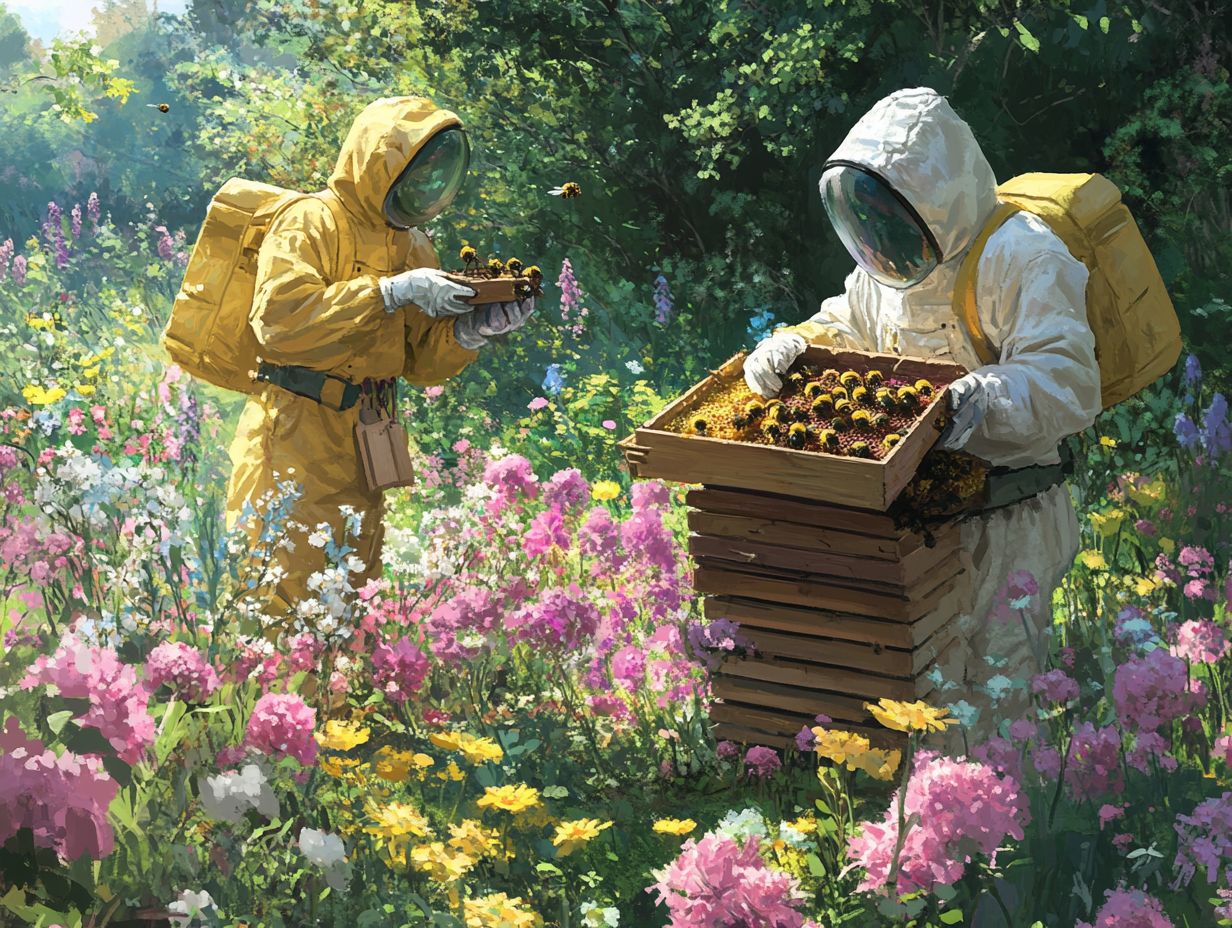
Rare bee species, including unique subspecies of solitary bees and other uncommon types, are vital to biodiversity. They perform essential functions within their ecosystems. However, these remarkable creatures are increasingly under threat from environmental changes and human activities that jeopardize their populations.
Notable examples of rare bees include the common eastern bumble bee, Asian honey bee, garden bumble bee, cuckoo bees, leaf-cutter bees, and mason bees.
What Makes a Bee Species Rare?
A bee species is deemed rare due to a combination of factors, including limited distribution, specific habitat requirements, and declining populations. These declines are often brought about by habitat loss, environmental changes, and competition with invasive plant species.
Many of these remarkable pollinators depend on particular plants for foraging and nesting. When their natural habitats are destroyed, they face a critical loss of both food sources and shelter. Broader ecological shifts, such as changes in climate, can disrupt their reproduction cycles and behaviors, making it increasingly challenging for these bees to thrive.
Pesticide exposure, agricultural intensification, and urban development heighten these challenges. This creates a tight connection between the survival of certain bee species and the health of their ecosystems. The decline of these bees has significant implications that extend beyond their immediate survival. The process of plant pollination, essential for food production, becomes increasingly jeopardized.
Why Are Rare Bee Species Important?
Rare bee species are vital for biodiversity and healthy ecosystems. They play unique roles in pollination, contributing significantly to ecosystem health and the survival of flowering plants and agricultural crops.
The decline of these bees is concerning. Many plants rely on specific bee species for effective pollination. When rare pollinators decrease, plant diversity diminishes, leading to fewer food sources for wildlife and disrupting ecosystems.
Robust bee populations are essential for producing fruits, nuts, and vegetables. Protecting these species is crucial for sustaining our environment and ensuring food security.
What Are the Most Endangered Bee Species?
The bee species most at risk face severe threats such as habitat loss, climate change, and pesticide exposure. These pressures lead to alarming declines in their populations, jeopardizing biodiversity and the overall health of ecosystems.
What Are the Causes of Risk of Extinction for These Bee Species?
Understanding the causes of risk of extinction for these bee species involves recognizing the impacts of climate change, habitat loss, and pesticide exposure on their populations.
The endangerment of bee species stems from multiple factors, including habitat loss due to urban development and agriculture, climate change altering their foraging patterns, and the detrimental effects of pesticides jeopardizing their health and survival. Vegetarian wasps and other non-native species can disrupt local bee populations.
As natural landscapes become fragmented, food sources dwindle, directly impacting the bees ability to thrive and reproduce. Invasive plant species often outcompete native flowers, resulting in a decline in the diversity of nectar sources essential for their diets. Furthermore, bee identification becomes harder, making conservation efforts more challenging.
The shifting climate brings about mismatched flowering times, meaning bees might emerge too early or too late to access the food they rely on during critical foraging periods. These challenges are interconnected, and we must act quickly to safeguard these crucial pollinators!
What Are the Conservation Efforts for These Bee Species?
Conservation efforts focus on restoring habitats and creating bee-friendly environments. Local communities, environmental groups, and government agencies unite to establish pollinator gardens that provide vital resources for these insects.
Public awareness programs are essential to enlighten individuals about the critical role bees play in our ecosystem and inspire community participation in hands-on restoration projects. For instance, workshops teaching how to grow native plants significantly enhance local bee habitats.
The success of conservation measures is evident in regions where protective policies are enacted, leading to a noticeable resurgence in bee populations and diversity.
How Can Beekeepers Help Protect Rare Bee Species?
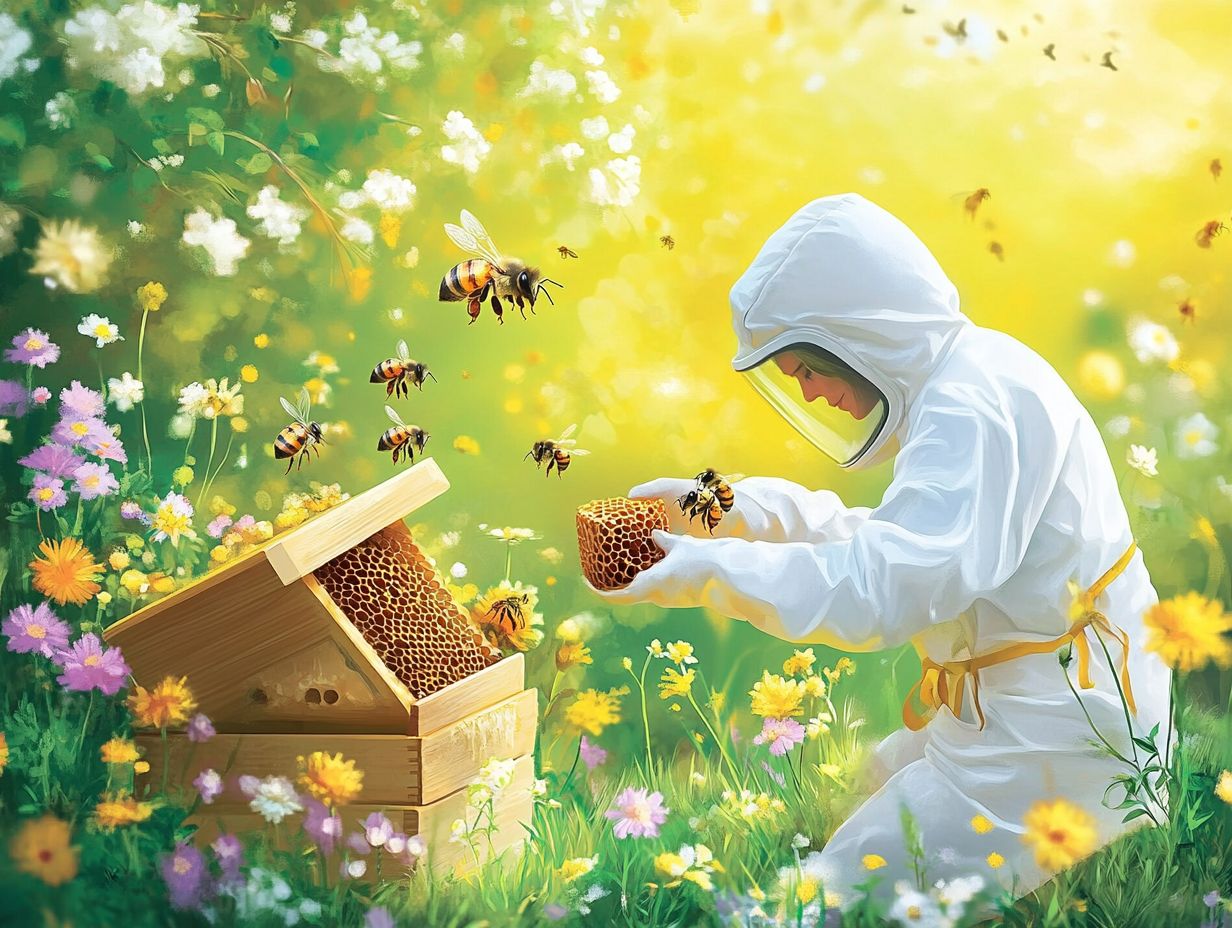
As a beekeeper, you hold a vital responsibility in safeguarding rare bee species. Through your dedication to conservation practices, you engage in habitat restoration, cultivate pollinator-friendly gardens, and enlighten your community about the significance of bee conservation.
Your efforts not only contribute to the well-being of these essential creatures, such as the European Honey Bee and the Asian Honey Bee, but also foster a deeper appreciation for their role in our ecosystem.
What Practices Can Beekeepers Implement to Protect Rare Bee Species?
You can take significant steps as a beekeeper to create safe havens for rare bee species by implementing practices like establishing pollinator-friendly gardens, using native plants, and participating in habitat restoration projects. These efforts are crucial for distinct bee families like the Andrenidae family and the Colletidae family.
Consider setting up wildflower meadows and adopting sustainable beekeeping methods that minimize chemical usage. This approach not only nurtures a healthier ecosystem but also supports the local bee population, including short-tongued bees, medium-tongued bees, and long-tongued bees. For instance, by planting a diverse array of flowers that bloom at different times throughout the growing season, you can ensure a continuous food source for your bees. Incorporating organic farming practices allows you to foster broader biodiversity, benefiting not just the bees but also other wildlife and promoting soil health.
These efforts contribute significantly to the conservation of fragile bee populations while simultaneously enhancing crop yields. This highlights the intricate relationships between agriculture and environmental stewardship, showcasing how your actions can lead to a more sustainable future. By attracting different bee species like Bumble Bees, Squash Bees, and the Buttercup Blood Bee, your garden can become a thriving pollinator haven.
How Can Beekeepers Support Conservation Efforts for Rare Bee Species?
You have a unique opportunity to support conservation efforts for rare bee species by partnering with environmental organizations like Global Wildlife Conservation, engaging in research initiatives, and spreading awareness about the importance of bee conservation.
By collaborating with local conservation groups, you can help design and implement community outreach programs that emphasize the urgent need to protect these vital pollinators. Sharing your firsthand knowledge through workshops, talks, or social media campaigns can inspire others to understand the ecological roles bees play, such as their pollination work, and the threats they face.
Engaging with schools and community organizations allows you to create a platform for interactive education, where participants can appreciate the beauty and complexity of various bee species, including the Domino Cuckoo Bee and the Teddy Bear Bee. Ultimately, these collaborative efforts can cultivate a sense of stewardship within your community, motivating individuals to take action to preserve the diverse and essential bee populations that significantly contribute to our ecosystems.
What Can Individuals Do to Help Protect Rare Bee Species?
You can take meaningful steps to protect rare bee species, such as the Violet Carpenter Bee, by cultivating bee-friendly environments in your garden, supporting local conservation initiatives, and advocating for policies that safeguard bee habitats while minimizing pesticide use.
How Can People Create Bee-Friendly Environments?
Creating bee-friendly environments is all about growing native plants that provide ample forage and steering clear of pesticides. Embracing sustainable gardening practices nurtures healthy bee populations, including types of bees from the Megachilidae and Stenotritidae families.
To foster a thriving habitat for these vital pollinators, research and select a variety of flowering plants that are indigenous to your region. Local species are far more likely to attract the bees that call your area home.
Establishing a diverse garden with blossoms that offer nectar and pollen throughout the growing season is key. This ensures bees have a reliable food source from early spring to late autumn.
Providing shelters for solitary bees is equally important. Incorporate natural elements like dead wood or bee hotels into your garden. You should adopt a mechanical approach to weed management, rather than relying on harmful chemicals, to support a healthier ecosystem.
By practicing mindful mowing and leaving some areas of your garden wild, you can promote essential habitats for bees to flourish. This includes creating environments that benefit both short-tongued bees and long-tongued bees.
What Can People Do to Support Conservation Efforts for Rare Bee Species?
Supporting conservation for rare bees is a fantastic way to make a real difference! By participating in local initiatives, you can raise awareness about declining bee populations and advocate for policies that safeguard their habitats.
This engagement is vital for species like the Xerces Society-listed Buttercup Blood Bee. You have the chance to join local conservation groups dedicated to protecting these essential pollinators and their ecosystems.
Engaging in educational outreach programs is a wonderful way to share knowledge with others. Help them understand just how crucial bees are to our food systems and biodiversity.
Backing legislation that focuses on habitat protection and promoting sustainable agricultural practices can help cultivate a more welcoming environment for these essential creatures.
Remember, every small action you take adds to a collective movement. Highlight the significance of community engagement in ensuring the survival of these invaluable species. Organizations like Global Wildlife Conservation also play a pivotal role in supporting these efforts.
Frequently Asked Questions
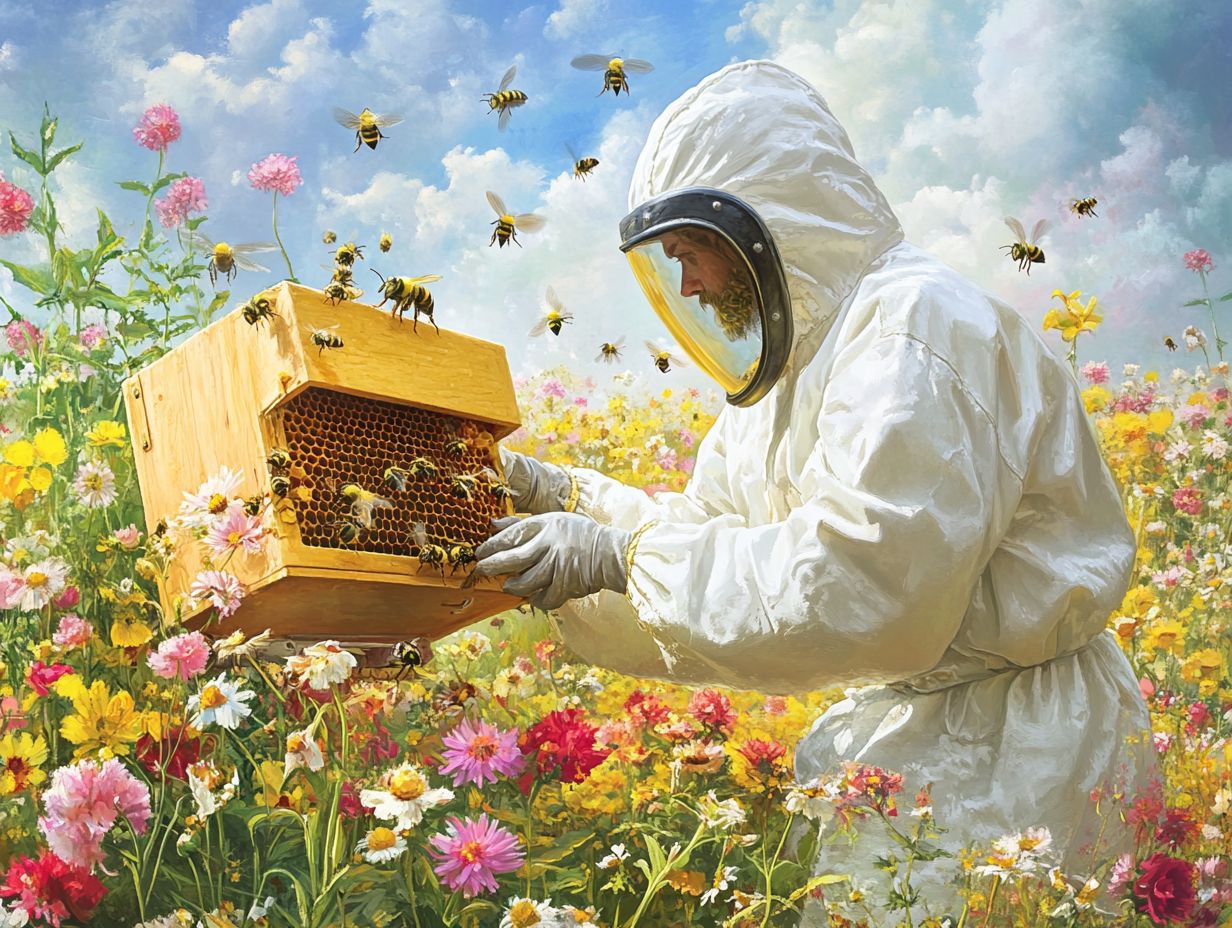
What is beekeeping and why is it important for rare bee species?
Beekeeping is the practice of raising and caring for bees, typically for their honey and other products. It is important for rare bee species because it helps preserve and protect their populations, as well as maintain biodiversity and pollination in ecosystems.
Learning about the bee lifecycle and different bee behaviors can greatly enhance your beekeeping practices.
What makes a bee species rare?
A bee species is considered rare when its population is dwindling and it is at risk of becoming extinct. This can be due to habitat loss, pesticide use, and other environmental factors.
Notable rare species include the Xerces Society-listed Buttercup Blood Bee.
How can beekeepers help to protect and support rare bee species?
Beekeepers can help by providing suitable habitats for rare bee species. This includes planting native flowers and avoiding the use of pesticides.
They can also join conservation efforts and educate others about the importance of protecting rare bees. Figures like Noah Wilson-Rich and resources such as the State of the Honey Bee report provide valuable insights.
Are there any specific techniques or methods used in beekeeping for rare bee species?
Yes, there are specialized beekeeping techniques that focus on the preservation and protection of rare bee species.
This includes careful monitoring of hives, using specific types of hives suitable for rare bees, such as honey bee hives, and implementing sustainable and natural methods of beekeeping.
Are there any laws or regulations in place for beekeeping and protecting rare bee species?
Yes, many countries have laws to protect rare bee species and their habitats.
In the United States, the Endangered Species Act and the Federal Insecticide, Fungicide, and Rodenticide Act help safeguard these bees.
In Europe and Asia, there are similar protections for regional bee species.
Can I still enjoy the benefits of beekeeping if I am focused on preserving rare bee species?
Absolutely! Beekeeping can be both rewarding and conservation-focused.
By using sustainable methods, you can produce honey and other products while helping protect rare bees.
The unique design of honey bee hives supports their survival and productivity.

